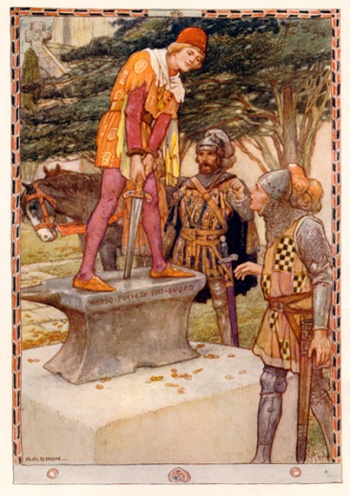
CharactersName Variants: Arthure, Artur, King Arthur
http://d.lib.rochester.edu/camelot/theme/arthur
King Arthur is the figure at the heart of the Arthurian legends. He is said to be the son of Uther Pendragon and Ygraine of Cornwall. Arthur is a near mythic figure in Celtic stories such as Culhwch and Olwen. In early Latin chronicles he is presented as a military leader, the dux bellorum. In later romance he is presented as a king and emperor. One of the questions that has occupied those interested in King Arthur is whether or not he is a historical figure. The debate has raged since the Renaissance when Arthur's historicity was vigorously defended, partly because the Tudor monarchs traced their lineage to Arthur and used that connection as a justification for their reign. Modern scholarship has generally assumed that there was some actual person at the heart of the legends, though not of course a king with a band of knights in shining armor--though O.J. Padel in "The Nature of Arthur" argues that "historical attributes of just the kind that we find attached to Arthur can be associated with a figure who was not historical to start with." If there is a historical basis to the character, it is clear that he would have gained fame as a warrior battling the Germanic invaders of the late fifth and early sixth centuries. Since there is no conclusive evidence for or against Arthur's historicity, the debate will continue. But what can not be denied is the influence of the figure of Arthur on literature, art, music, and society from the Middle Ages to the present. Though there have been numerous historical novels that try to put Arthur into a sixth-century setting, it is the legendary figure of the late Middle Ages who has most captured the imagination. It is such a figure, the designer of an order of the best knights in the world, that figures in the major versions of the legend from Malory to Tennyson to T. H. White. Central to the myth is the downfall of Arthur's kingdom. It is undermined in the chronicle tradition by the treachery of Mordred. In the romance tradition that treachery is made possible because of the love of Lancelot and Guinevere.
King Arthur is the figure at the heart of the Arthurian legends. He is said to be the son of Uther Pendragon and Ygraine of Cornwall. Arthur is a near mythic figure in Celtic stories such as Culhwch and Olwen. In early Latin chronicles he is presented as a military leader, the dux bellorum. In later romance he is presented as a king and emperor. One of the questions that has occupied those interested in King Arthur is whether or not he is a historical figure. The debate has raged since the Renaissance when Arthur's historicity was vigorously defended, partly because the Tudor monarchs traced their lineage to Arthur and used that connection as a justification for their reign. Modern scholarship has generally assumed that there was some actual person at the heart of the legends, though not of course a king with a band of knights in shining armor--though O.J. Padel in "The Nature of Arthur" argues that "historical attributes of just the kind that we find attached to Arthur can be associated with a figure who was not historical to start with." If there is a historical basis to the character, it is clear that he would have gained fame as a warrior battling the Germanic invaders of the late fifth and early sixth centuries. Since there is no conclusive evidence for or against Arthur's historicity, the debate will continue. But what can not be denied is the influence of the figure of Arthur on literature, art, music, and society from the Middle Ages to the present. Though there have been numerous historical novels that try to put Arthur into a sixth-century setting, it is the legendary figure of the late Middle Ages who has most captured the imagination. It is such a figure, the designer of an order of the best knights in the world, that figures in the major versions of the legend from Malory to Tennyson to T. H. White. Central to the myth is the downfall of Arthur's kingdom. It is undermined in the chronicle tradition by the treachery of Mordred. In the romance tradition that treachery is made possible because of the love of Lancelot and Guinevere.
BIBLIOGRAPHY
Ashe, Geoffrey. The Discovery of King Arthur. Garden City, NY: Anchor Press/Doubleday, 1985.
Barber, Richard. The Figure of Arthur. Cambridge: D.S. Brewer, 1972.
Chambers, E. K. Arthur of Britain. New York: October House, 1967.
Jones, W. Lewis. King Arthur in History and Legend. Cambridge: Cambridge University Press, 1911.
King Arthur: A Casebook. Ed. Edward Donald Kennedy.New York: Garland, 1996.
Korrel, Peter. An Arthurian Triangle: A Study of the Origin, Development and Characterization of Arthur, Guinevere and Modred. Leiden: E. J. Brill, 1984.
Morris, Rosemary. The Character of King Arthur in Medieval Literature. Cambridge: D. S. Brewer, 1982.
Padel, O.J. "The Nature of Arthur." Cambrian Medieval Celtic Studies 27 (Summer 1994): 1-31
Ashe, Geoffrey. The Discovery of King Arthur. Garden City, NY: Anchor Press/Doubleday, 1985.
Barber, Richard. The Figure of Arthur. Cambridge: D.S. Brewer, 1972.
Chambers, E. K. Arthur of Britain. New York: October House, 1967.
Jones, W. Lewis. King Arthur in History and Legend. Cambridge: Cambridge University Press, 1911.
King Arthur: A Casebook. Ed. Edward Donald Kennedy.New York: Garland, 1996.
Korrel, Peter. An Arthurian Triangle: A Study of the Origin, Development and Characterization of Arthur, Guinevere and Modred. Leiden: E. J. Brill, 1984.
Morris, Rosemary. The Character of King Arthur in Medieval Literature. Cambridge: D. S. Brewer, 1982.
Padel, O.J. "The Nature of Arthur." Cambrian Medieval Celtic Studies 27 (Summer 1994): 1-31
No comments:
Post a Comment